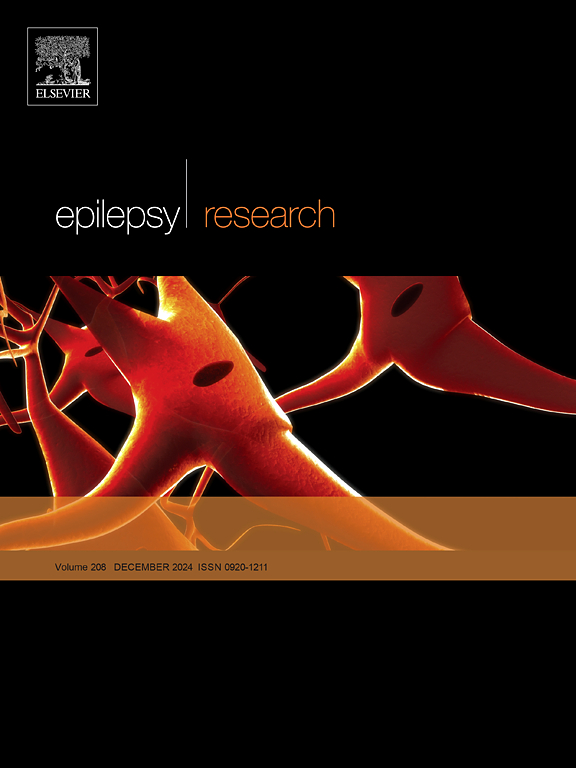UGT polymorphisms and epileptic seizure control in pregnant women treated with Lamotrigine
IF 2
4区 医学
Q3 CLINICAL NEUROLOGY
引用次数: 0
Abstract
Objective
We investigated whether polymorphisms of selected uridine-diphospho-glucuronosyl-tranferases (UGT) involved in Lamotrigine (LTG) metabolism are associated with seizure control during pregnancy and post-partum in women with epilepsy treated with LTG.
Methods
Single nucleotide polymorphisms for UGT1A4 * 2 (P24T, c.70 C>A), UGT1A4 * 3 (L48V c.142 T > G) and UGT2B7 * 2 (H268Y, c.802 C>T), were determined in 47 pregnancies in 40 non-smoking women with LTG-treated epilepsy. Retrospectively collected data included seizure type and frequency, LTG dosage and LTG plasma level changes during pregnancy and PP. We evaluated the effect of UGT genotype on seizure control throughout pregnancy and post-partum (T1-PP).
Results
In 47 pregnancies, seizure control was achieved in 60 % in T1-PP. Occurrence of seizures T1-PP was not directly associated with UGT genotype, but with having pre-pregnant seizures within the past 6 months (OR 8.33 (95 % CI 1.53–45.41, p = 0.01) and 12 months (OR 5.25, 95 % CI 1.47–18.77, p = 0.02) preceding pregnancy.
Conclusion
We did not observe any proximate effect of UGT genotypes on seizure control during pregnancy and post-partum in women treated with LTG, but seizures within the year preceding pregnancy had a significant impact.
拉莫三嗪治疗孕妇UGT多态性与癫痫发作控制
目的探讨参与拉莫三嗪(LTG)代谢的尿嘧啶二磷酸葡萄糖醛酸转移酶(UGT)多态性是否与妊娠和产后癫痫患者服用LTG治疗的癫痫发作控制有关。MethodsSingle核苷酸多态性对UGT1A4 * 2 (P24T, c.70 C> A), UGT1A4 * 3 (L48V c.142 T 祝辞 G)和UGT2B7 * 2 (H268Y, c.802 C> T),测定在47个怀孕40 LTG-treated癫痫不吸烟的女性。回顾性收集资料,包括癫痫发作类型、发作频率、LTG剂量及血浆LTG水平在妊娠期和产后的变化。我们评估UGT基因型对整个妊娠期和产后(T1-PP)癫痫发作控制的影响。结果47例妊娠中,癫痫发作控制率为60% %。癫痫发作T1-PP的发生与UGT基因型无直接关系,但与妊娠前6个月(OR 8.33(95 % CI 1.53-45.41, p = 0.01)和妊娠前12个月(OR 5.25, 95 % CI 1.47-18.77, p = 0.02)发生过孕前癫痫发作有关。结论我们没有观察到UGT基因型对LTG治疗妇女妊娠期和产后癫痫发作控制的直接影响,但妊娠前一年的癫痫发作有显著影响。
本文章由计算机程序翻译,如有差异,请以英文原文为准。
求助全文
约1分钟内获得全文
求助全文
来源期刊

Epilepsy Research
医学-临床神经学
CiteScore
0.10
自引率
4.50%
发文量
143
审稿时长
62 days
期刊介绍:
Epilepsy Research provides for publication of high quality articles in both basic and clinical epilepsy research, with a special emphasis on translational research that ultimately relates to epilepsy as a human condition. The journal is intended to provide a forum for reporting the best and most rigorous epilepsy research from all disciplines ranging from biophysics and molecular biology to epidemiological and psychosocial research. As such the journal will publish original papers relevant to epilepsy from any scientific discipline and also studies of a multidisciplinary nature. Clinical and experimental research papers adopting fresh conceptual approaches to the study of epilepsy and its treatment are encouraged. The overriding criteria for publication are novelty, significant clinical or experimental relevance, and interest to a multidisciplinary audience in the broad arena of epilepsy. Review articles focused on any topic of epilepsy research will also be considered, but only if they present an exceptionally clear synthesis of current knowledge and future directions of a research area, based on a critical assessment of the available data or on hypotheses that are likely to stimulate more critical thinking and further advances in an area of epilepsy research.
 求助内容:
求助内容: 应助结果提醒方式:
应助结果提醒方式:


